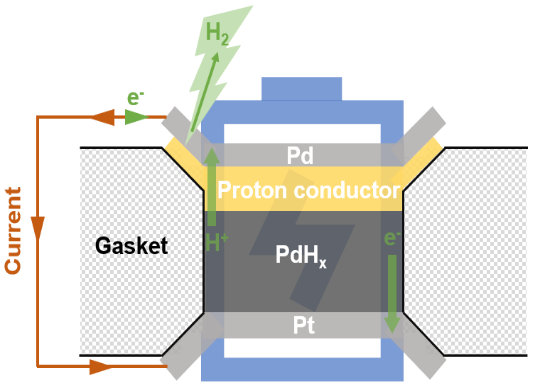
Metal hydrides have many applications in energy science, such as for hydrogen or heat storage materials, additives in energetic materials, and electrode materials in batteries. Using a large pressure gradient can propel the hydrogen atoms out of the material. Therefore, a piezovoltaic device, a pressure gradient-driven battery (PGDB), can be realized when the migrations of protons and electrons are separated by different conductors. Excitingly, a team led by Dr. Kuo Li from HPSTAR and Dr. Jie Zheng from Peking University have experimentally detected a PGDB with an output current of ≲40 nA and a voltage of ≲0.8 V for a 3 μg PdHx sample in their recent report “Piezovoltaics from PdHx” published in the Journal of Physical Chemistry Letters.
By employing PdHx as an anode, the group successfully realized a powerful piezovoltaic device PdHx-Pd PGDB with an open-circuit voltage of ≲0.8 V and demonstrated the escape of hydrogen from the palladium lattice under an increasing pressure gradient using X-ray diffraction (XRD). A Pd (cathode, PG)|proton conductor (electrolyte, PG)| PdHx (anode, HP)|Pt (wire, PG) PGDB was prepared with different proton conductors as shown below, where PG and HP represent a pressure gradient and high pressure, respectively. PdHx is the anode that provides protons to the electrolyte (proton conductors) on the top side, which transport the protons to the palladium electrode (cathode) but block electrons. Potassium hydroxide (KOH), phosphomolybdic acid hydrate (PMA), and phosphotungstic acid hydrate (PTA) were used as electrolytes because as all of them have robust structures under applied pressure. On the bottom side of PdHx, platinum foil transports electrons to ambient pressure but blocks protons. The electrons are transferred through the circuit and recombine with protons at the cathode.
This is an electrochemical process in contrast to piezoelectricity, where the piezoelectric material is polarized under an external force with positive and negative charges concentrated on two opposite surfaces (physical process). Instead, the relationship between the piezovoltaic and piezoelectricity is just like that between the chemical battery, which includes an electrochemical reaction and the capacitor that only involves the physical process of charge separation.

Caption: Gibbs free energy changes contributed by applied pressure.
This work demonstrates an unprecedented piezovoltaic application of metal hydride as a PGDB and provides a new way to convert mechanical energy into electrical energy. Consequently, metal hydride can be considered not only a container for hydrogen storage but also a battery “fuel” for generating electricity in the process of releasing hydrogen.
近日,北京高压科学研究中心的李阔和郑海燕研究员课题组和北京大学郑捷课题组通过金属氢化物PdHx的压伏性质的研究,展示了金属氢化物的在压伏方面的应用潜力,并提出了一种将机械能转化为电能的新方法。相关结果发表在近期的《物理化学快报》(DOI: 10.1021/acs.jpclett.3c00464)上。